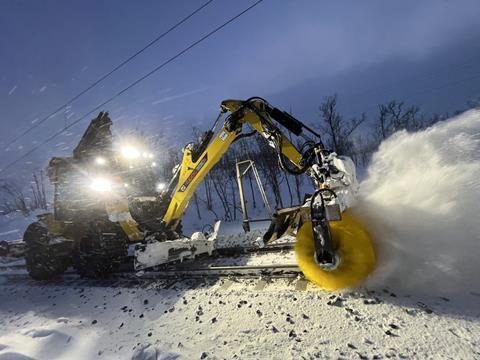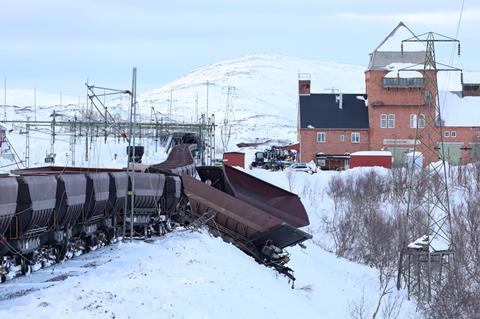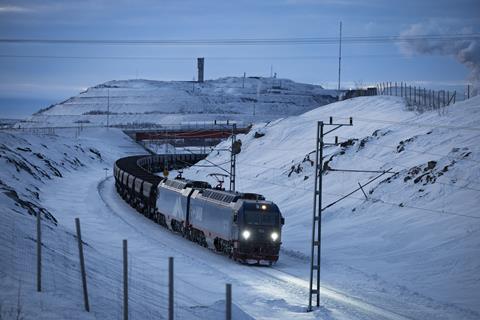SWEDEN: Two derailments in quick succession on the single-track railway between Kiruna and Narvik have raised serious questions and fuelled calls to double-track the heavily used line. Toma Bačić reports.

Trains carrying iron ore over the 169 km section of the single-track Malmbanan from Kiruna in Sweden to the Norwegian port of Narvik were suspended for a second time within 10 weeks following derailment of a Kiruna-bound empty train between Katterjåkk and Vassijaure just before 20.00 on February 24. Three ore wagons left the track, causing damage to track, signalling and the 15 kV 16∙7 Hz overhead wires over 1∙5 km of the alignment.
At 21.00 on March 6 Swedish transport administration Trafikverket reopened the line, and the first loaded ore train left Kiruna for Narvik. A reduced operating speed of 40 km/h and reduced train and axleloads will apply for an unspecified period, and Trafikverket will conduct daily track inspections. The line remains closed to passenger services.
The February accident happened about 6 km north of the site of a more serious derailment on December 17 last year when a loaded train came off the rails at the western end of Vassijaure station, near the Norwegian border around 121 km northwest of Kiruna. The train was at that moment passing through a snowshed, and damage to the track and other infrastructure was severe enough to halt the resumption of iron ore shipments until February 18 ― only for the second accident to once again force closure of the line.

State-owned mining company LKAB told Railway Gazette on March 6 that ‘the February derailment was not on the track that was repaired after the derailment in December’.
The first derailment led to track having to be relaid over a 6 km stretch, with 26 000 sleepers replaced over the 15 km between Tornehamn and Vassijaure and six sets of points renewed. Repairs were hampered by heavy snowfall, wind speeds of 10 m/sec to 30 m/sec and temperatures as low as -35°C, to say nothing of almost total darkness at a site about 145 km north of the Arctic Circle.
Loss or revenue
Both LKAB and privately-owned Kaunis Iron were severely affected by the two derailments. For LKAB, halting traffic meant a loss of revenue of around SKr100m per day. For Kaunis Iron, which mines iron ore in Pajala and ships it by rail between Svappavaara and Narvik, the accidents forced production to be cut back as only limited storage capacity was available.
With 10 fully loaded trains a day, the Kiruna – Narvik section of the Malmbanan (which includes the 40 km in Norway known as the Ofotbanen between Rijksgränsen and Narvik) accounts for about two-thirds of LKAB’s deliveries of iron ore products. On the 304 km southern section from Kiruna to Gällivare and Luleå on the Gulf of Bothnia there are four or five trains a day, but line capacity does not allow additional trains to run to Luleå if the Kiruna – Narvik section is closed.
Repair work
Repairs to the track and infrastructure began on December 23, with the ore wagons and the 12-axle twin-unit IORE electric locomotive removed from the site and up to 100 staff deployed to restore the track and other infrastructure. BDX Rail and several subcontractors were commissioned to complete the work.

By December 27 LKAB Malmtrafik CEO Caroline Wiss was able to say that ‘work has progressed well, despite sub-zero temperatures and darkness, and we are maintaining regular and close dialogue with both the Haverikommissionen (the Swedish Accident Investigation Authority) and Trafikverket … we have seen that a wheelset on one of the ore cars is damaged. For safety reasons, we have withdrawn the 40 ore cars that are equipped with wheelsets from the same consignment. We are now awaiting the outcome of Haverikommissionen’s investigation.’
The first test train formed of a T46-3 Co-Co diesel locomotive and ore wagons ran over the repaired section on February 14. Further tests were made and an electric locomotive with 68 ore wagons completed a trial run on February 18 before the line reopened two days later, albeit for freight traffic only. Trafikverket currently expects passenger traffic between Abisko Östra and Narvik to be reintroduced from May 31.
Tests completed
Simon Sunna, Head of Järnväg Region Nord at Trafikverket, said ‘we have made checks and measurements to see how the railway copes with the load. The tests show that we can now allow freight traffic on the derailment section, but with restrictions such as speed reductions in order to be able to operate under the safest possible conditions.
‘With the snow and ice on the site, we do not have the opportunity to inspect every detail of the track as we would normally have done during an inspection prior to commissioning the railway. Such an inspection would mean not opening to traffic until June. It is not an option for our operators or for us’, he continued, noting that ‘we have restored the track under extreme weather conditions; people and machines have worked in temperatures down to -30°C and in blizzards and storms. Our contractors, together with Trafikverket staff, have made an incredible effort.’
Although regular traffic resumed, axleloads were limited to 25 tonnes compared with the normal limit of 31 tonnes. Malmbanan trains had run with 25 tonne axleloads until March 2001, when the limit was raised to 30 tonnes. Testing for a further increase to 31 tonnes began in 2021, and this was later authorised with a long-term objective of raising the limit to 32∙5 tonnes. Logistics Manager for LKAB Linda Bjurholt expected ‘that the limitation of the axleload will apply for about a week and during that time we will be allowed to run with less ore in the trains’.
Asserting that ‘our locomotives, wagons and terminals [are] in top condition, ready for restarting the operations’, Bjurholt did not expect LKAB to have cleared the backlog of pellet ore stored temporarily in Kiruna and Svappavaara for one or two years. Around 3 million tonnes of ore, corresponding to more than 400 loaded trains, had to be stockpiled pending resumption of shipments to Narvik.
The maximum speed over the 20 km between Björkliden and Vassijaure was initially limited to 40 km/h compared with the normal loaded train speed of 60 km/h; empty ore trains are usually permitted to run at 70 km/h and most other freight trains at 100 km/h. The lower speed means that running times for loaded trains have increased by up to 7 min, with empty trains requiring another 10 min, leading to a drop in line capacity. Trafikverket was obliged to introduce a temporary timetable between Kiruna and Riksgränsen.

A spokesperson for Kaunas Iron said that ‘our aim is to catch up on lost deliveries due to the derailment in around 12 months. That includes additional departures on top of our normal train schedule. Luleå is no option for Kaunis Iron because there is no supporting infrastructure for us there, so our ore goes only to Narvik. The accumulated volume due to the derailment amounts to about 500 000 tonnes.’
LKAB told Railway Gazette at the end of February that ‘we don’t yet know how much we will have lost because of the derailment, as we will deal with the consequences for many years, but we lost revenue of SKr100m a day because we could not deliver. We will see how much of that we can get back. For now, we are not able to increase traffic as the line lacked capacity even before the derailment. In fact, the line needs further maintenance work in the years to come, which will actually lead to even lower capacity.’
Previous interruptions to traffic on the Malmbanan include the derailment in November 2021 of 38 wagons of an 8 000 tonne loaded ore train near Gällivare and a derailment of another loaded train at Narvik in March 2023.
Call for double track
On February 21 several Swedish and Norwegian companies wrote to the governments of Sweden and Norway calling for double tracking of the Malmbanan and the Ofotbanen between Riksgränsen and Narvik. Signatories included LKAB, steel company H2 Green Steel, the Norrbotten Chamber of Commerce, the municipalities of Luleå, Kiruna and Narvik, the Swedish Tourism Association and Volvo.

















